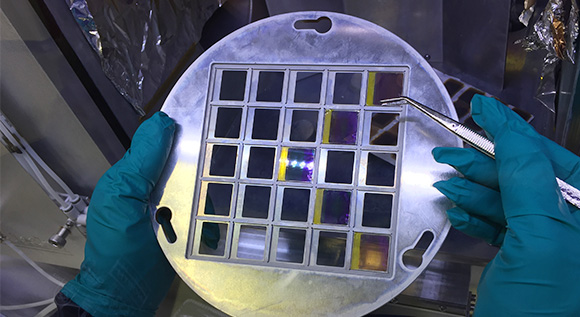Two are better than one – generating more electricity thanks to tandem solar cells
The type of solar cell we are currently using can barely be optimised any further. This means that if we want to generate solar electricity in a more affordable way, we need to come up with new ideas. A very promising one is the tandem solar cell – the development of which is being funded by the Federal Ministry for Economic Affairs and Energy.
 © Fraunhofer ISE
© Fraunhofer ISE
Anyone who has been on a tandem bicycle before knows that two is better than one. This also applies to solar cells: two cells generate more electricity than one single cell. This is the underlying principle of the tandem solar cell, which consists of two different types of solar cell stacked on top of each other that transform different parts of the solar spectrum into electricity.
Combining solar cells that absorb blue, green and red light
More than 90 per cent of the solar cells that we regularly see on rooftops are made of silicon and absorb blue light. This type of solar cell is reliable, and is available at a reasonable price. However there is one problem: only 20 to 22 per cent of the sun’s energy captured by this type of solar cell can be converted into electricity. And experts believe that it is is technically impossible to reach a maximum efficiency of more than 26 to 27 per cent.
In order to solve this problem, the tried-and-tested silicon cell is partnered with a perovskite cell, leading overall efficiency to rise to more than 30 per cent (to find out more about maximum efficiency, please click here). The perovskite cell is particularly thin, can be used in many different ways, and is also cheap to produce. What is even more important is that unlike the silicon cell which absorbs (infra)red light, the perovskite cell absorbs green and blue light to generate electricity. The red light is passed through the upper layer of the cell to the silicon layer below. The tandem solar cell, which combines these two types of solar cells, can generate more electricity than a single cell, which means that it has a much higher maximum efficiency.
More research needed before the tandem solar cell can be brought to the market
Up until now, the tandem solar cell is not available on the market. In order to change this, more research will be needed. Scientists need to optimise the way the two cells are stacked on top of each other so that as much electricity as possible can be generated. As perovskite cells contain lead, it also needs to be ensured that this material can be adequately recycled so that it does not harm the environment. This is exactly what PersiST – a project launched by the Fraunhofer Institute for solar energy systems, Freiburg University, Helmholtz-Zentrum Berlin for materials science, and two commercial partners – seeks to do. The goal of this project is to create a stable, environmentally-friendly and efficient tandem cell that has a maximum efficiency of around 30 per cent and that reduces the cost of cell production by around 30 per cent. If we get this right, tandem cells could compete on the market and greatly help to further cut the cost of renewable electricity. The Federal Ministry for Economic Affairs and Energy is providing funding of around €4.3 million for this research project.
An overview of the Federal Ministry’s programmes that serve to fund energy research can be found in the 2017 Federal Report on Energy Research (in German only). Find out more by clicking here.

